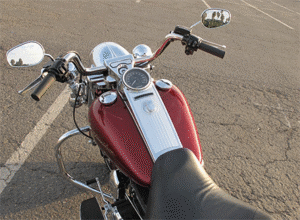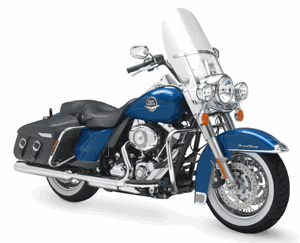Sometimes you just want to ride. You don’t want to make a statement, cause a scene, or otherwise disrupt a fun time. Well, Mr., Mrs., Miss, or, Ms., the 2010 Harley-Davidson FLHR Road King awaits you. It’s not that the Road King isn’t a good-looker, or that you can’t flash it up if you so desire. Certainly you can do all that, and more, but the standard Road King comes across as a very competent, no nonsense, adult –as in you’ve no need to scream “Look at me, look at me!”—-motorcycle. Sound boring? No way, it just goes about its travel a bit differently from its more flashy brethren.
The Road King was introduced in 1995, more or less a successor to the FLHS Electra Glide Sport. That model proved that there was a market for a touring Harley that featured a large windshield, rather than the traditional “bat wing” fairing. The Road King quickly established its own identity, and became a top seller. Newer models such as the Street Glide, have eclipsed its popularity, but savvy Harley owners know that you get a lot for your Road King dollar.
One of the big advantages to the King is its quickly detachable windshield. With the shield on you probably have 75 percent of the weather protection you get with the Electra Glides, but in about ten seconds …if you’re slow… the windshield pops off and you have a very stylish cruiser.
Another advantage to this set up is that the Road King weighs 52 pounds less than, for example, the Electra Glide Classic. The impact of this is that, 1) the Road King handles easier, and is more maneuverable at low speeds, and , 2) you can carry 52 more pounds of load than with the Electra Glide. In addition to reduced weather protection you also lose the full gauge set and the radio.

As the Road King and Electra Glide both use the excellent Twin Cam 96, six-speed motor, the King’s more svelte self has a small edge in performance. It does not, however, give better gas mileage numbers as the windshield is less aerodynamic than the bat wing fairing. At reasonable speeds, the King returned 39mpg to 44mpg numbers over about 1,300 miles of varied travel. These figures will give you between 234 and 264 miles per 6-gallon tank. Harley cites a high of 54 miles per gallon, which would theoretically? give you a 324 mile range. If you’re very careful you might be able to nurse that mileage out of the King, but that’s not a real world number.
If you’ve read my tests over the years you know that I do not like tank-mounted speedometers as found on the Softail models. Well, the Road King also has one, and I don’t like it here either. Placing the speedo, and attendant warning lights and turn signal indicators, on the tank cleans up the handlebars nicely, but it also requires that you remove your eyes from the road to view them… not a particularly safe thing to do. Also ?and this probably doesn’t apply to you? using a tank bag covers the speedometer completely (I’m a big fan of tank bags).

Whether in town or out on the highway, the Road King really shines. As mentioned, its ease of maneuverability makes threading traffic a breeze, and its 92 ft./lbs. of torque allow you to quickly squirt in and out of traffic holes. Aiding your path is a nice set of “passing lights” which, if you keep them switched on, present a very visible signature to oncoming traffic. Where I found the motorcycle most enjoyable was in the mountains. Particularly those serpentine roads with big sweeping turns. The lean angle is a modest 33 degrees on the right, and 31 degrees on the left, but you can maintain an entertaining pace on winding roads. Yeah, you’ll drag a floorboard or two, but they pivot so this type of hooliganism doesn’t upset the King. The new-for-2009 chassis is a marvel of rigidity, allowing you to hold a line without having to work at it. And, of course, the dual Brembo-sourced brakes up front haul down speed without drama. As your load varies you can adjust the rear air shocks to compensate. Harley has lagged behind the industry with its suspension components, but these air shocks do a decent job, particularly when riding one-up.
The FLHR Road King has a stablemate, the FLHRC Road King Classic. This “C” model sends thing upscale a bit what with wire wheels, “tooled” leather seat, leather-wrapped saddlebags, and wide whitewall tires. Personally, I think the 28-spoke cast wheels with narrow whitewalls, as on the standard King, is a more attractive package (and easier to keep clean), but then that’s why they make these two models; so you have a choice. Interestingly, while the Road King, and all the Electra Glides, switched over to a 17-inch front wheel in 2009, the Road King Classic stayed with the 16-incher. Riding each back-to-back, I could not tell a discernable difference between the two tire sizes.
So just who is this more “adult” Road King for? If you enjoy long-haul touring, and can do without better weather protection and a radio, you’ll find the Road King to be a very enjoyable, competent motorcycle. And if you do a lot of around town or commute travel, it is particularly adept due to its ease of handling. Plus, it gives you the flexibility of popping off the windshield and stylin’ your adult self around town. Not to be overlooked is the price advantage. While an FLHTC Electra Glide Classic will ding your wallet for $18,899, the Road King is $2,000 less, and the Road King Classic $1,000 less. For that kind of savings you can buy yourself a heavier jacket and an iPod to make up for what you’re missing with the ‘bat wingers.’








Thank you for your balanced review. What is your advise for a senior, 63 years, and wanting to get his first Road King 2011? Yes second-hand.
Never rode a big bike. Only 110 horsepower some 30 years ago. Did nine years of off roading with a Lada Niva 4X4.
Thank you.
JD, get an 09 or newer.
Really missing the good old days so got me a VTX 1300 with bags and windshield much like the Road King here.
Thanks for the memories Mark .